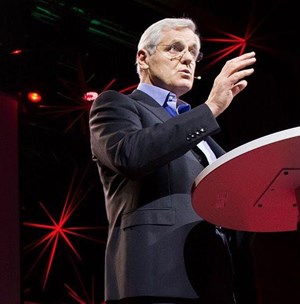
"If science can become instrumental in rediscovering the true values of our cultural heritage, and using widespread modern technologies attract the interest and curiosity of new generations, then I can see a new renaissance for the role of art in the future. Hopefully, in the decades to come people will still feel linked to their past if it will be identified as fundamental for the creation of their identity".
Image: Prof. Maurizio Seracini, courtesy to Prof. Maurizio Seracini
His field of expertise is related to applied science to conservation and authentication of works of art. In over forty years I have investigated over 3500 paintings. He believes that science and technology together with a new breed of scientists could play a disruptive role in the art market, proving or disproving the authenticity of works of art that today are sold based mainly on subjective evaluation of their attribution to a given artist.
Seracini’ s work has been highlighted in TED talks, and documentaries featuring his work can be seen on the National Geographic, Smithsonian ‘s The DaVinci Detective, and BBC channels. Also, his work was an inspiration for author Dan Brown's book, The Da Vinci Code.
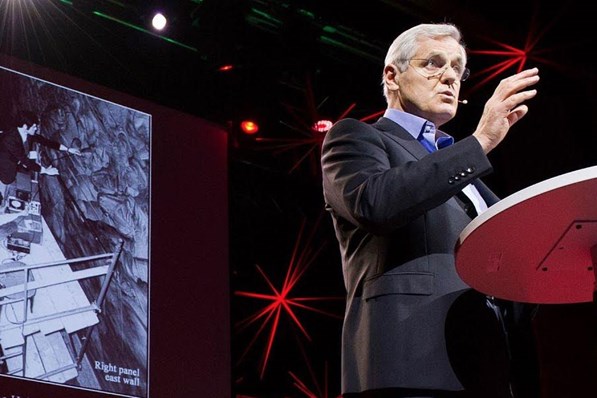
Prof. Maurizio Seracini, courtesy to Prof. Maurizio Seracini
Etienne Verbist, ArtDependence Magazine (AD) : Who are you and why do you do what you do?
Maurizio Seracini (MS): A 1973 graduate in bioengineering from the University of California, San Diego (UCSD), MSin 1977 founded in Florence Editech (Electronics, Diagnostics and Technology)the first private center in Europe to apply engineering sciences to the study of cultural heritage and to the authentication of works of art, adapting technologies from the medical, military and NDt field. I pioneered the use of multi-spectral diagnostic imaging, analytical diagnostics and other advanced technologies to study art and his scientific methodology has become a standard internationally in this field. He has studied more than 3500 works of art, including Leonardo Da Vinci's Last Supper, Adoration of the Magi, Botticelli's Allegory of Spring, Raphael’s Madonna of the Goldfinch and Caravaggio’s Medusa.
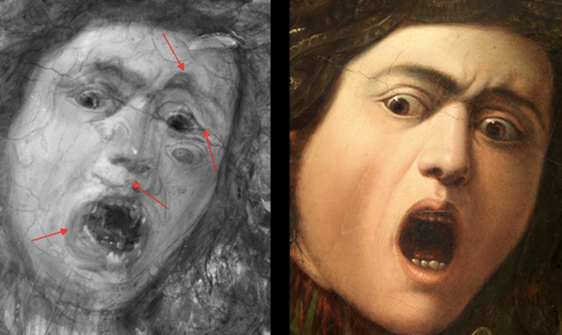
Diagnostic study on the Medusa Murtola by Caravaggio. The infrared reflectogram reveals under the painting layers changes introduced by the artist during the draft of a preparatory drawing
From 1975 to 2013, I was the scientific director of the Leonardo Project in search of the long-lost Leonardo’s mural The Battle of Anghiari in the Hall of the 500 in Palazzo Vecchio in Florence, a project sponsored by the Armand Hammer Foundation, the Kress Foundation, the Smithsonian Institution and the Kalpa Group of Loel Guinness.
In 2007, I founded the Center for Interdisciplinary Science for Art, Architecture and Archaeology (CISA3) at the University of California San Diego's California Institute for Telecommunications and Information Technology (Calit2). I was the director of CISA3 until 2013. A former National Geographic Fellow, in 2017 the Royal Photographic Society awarded him for his advances and breakthroughs in the application of Scientific Imaging to the world of Art and Cultural Heritage. Since 2017, I have joined SDSU to teach how to use applied sciences to fight art crimes. In 2018 I was the key note speaker at the AIA (Authentication in Art) congress in Amsterdam.
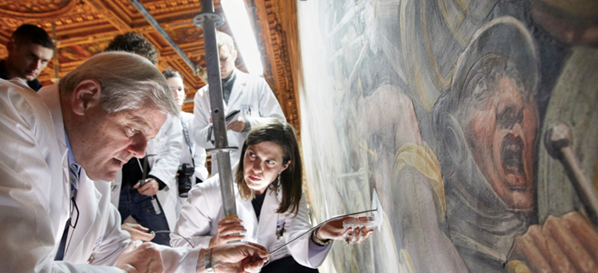
Fiber optics endoscopy investigations behind the Vasari’s frescoes in the Hall of the 500 in Palazzo Vecchio in Florence
AD: What was your most exiting study?
MS: The diagnostic studies on Leonardo’sThe Battle of Anghiari.
The Battle of Anghiari is a mural painting by Leonardo da Vinci located in the Sala del Gran Consiglio (today called The Hall of the 500) in Palazzo Vecchio in Florence. It is also known as “the Lost Leonardo”, dating back to the early 1500s. According to documents, Leonardo never completed the painting due to a defective batch of linseed oil while experimenting a faulty technique of Encausto, probably learned from Pliny. The mural painting disappeared when Vasari, the Medici architect, renovated the Hall of the 500 starting in 1563. Since 1975 Seracini has been engaged in an all-out investigation to find The Battle of Anghiari. In 2012 a 6mm endoscope fitted with a camera and tiny tweezers was used to peer through tiny holes drilled by state restorers into already fissured or restored areas of Vasari’s frescoes in order to prove the presence of an air gap between Vasari’s wall and the original wall and to collect samples from the latter.
Seracini reported his findings to a crowded press conference in 2013 stating that traces of pigments that appear to have been used exclusively by Leonardo were found.
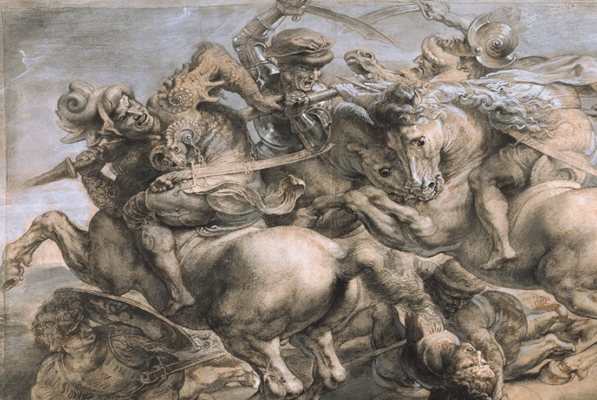
"Battle of Anghiari", Anonymous from the XVI century, reworked by Peter Paul Rubens in the XVII century
According to Discovery News, scanning electron microscopy revealed that the black material Seracini found had a chemical composition consistent with the one identified in da Vinci’s “Mona Lisa” and “St. John the Baptist.”
Seracini – whose work was exhibited as part of "The Mind of Leonardo Da Vinci" at Florence's Uffizi Gallery in 2006, and later at the U.S. Library of Congress – believes the Renaissance artist-scientist-inventor would be among the first to appreciate scientific analysis in the cause of understanding art. "We do justice to Leonardo," says Seracini. "We are using technology to understand his masterpieces. I think he would have been happy about that."
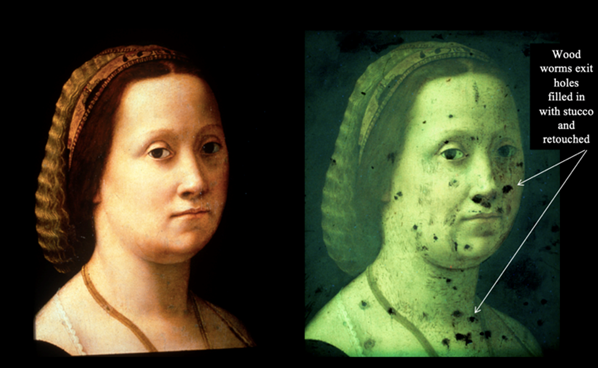
Left: Raphael "La Gravida" Galleria Palatina, Florence; right: ultraviolet fluorescence
AD: What is your goal?
MS: Even when I started what in 1977 appeared like an unheard and useless activity, I always had in mind a clear vision of two main goals:
To preserve world cultural heritage, much more than scholarly dissertations and an artisan approach to restoration would be needed. A cultural artefact should be seen as a patient and it should be treated as such, starting with the draft of a clinical chart to collect all the data related to the anamnesis, to its anatomy (we cannot know how and what a work of art is made of by default, since it is not the result of an industrial process), and its possible pathologies in order to reach a diagnosis which could indicate the necessity of changing the micro environment or make restoration (surgery) mandatory.
Science could play a fundamental and disruptive role in the art market introducing the concept of authentication versus attribution. These two terms even today are too often considered synonyms, to the extent that when a work of art is attributed to a specific artist, it is therefore considered authentic. My goal has always been to prove that authentication of a work of art should be done prior to attribution, and that it should the result of a thorough scientific investigation rather than a subjective and opinionated expertise done by an art historian.
AD: What will be the impact of what you do?
MS: Hopefully, conservation would become a true science, defined by specific methodologies and protocols and restoration should not be seen anymore as the only way to intervene on a work of art.
Like in medicine, where doctors interact with patients to reach a diagnosis and to outline a therapy, leaving surgery to surgeons, so in art conservation, the figure of the conservator scientist should be in charge of defining and monitoring the state of conservation of a work of art and to identify the most appropriate ways to slow down its decay. Restoration (surgery) should be seen as the last solution to conserve a work of art and it should be done by a team of restorers and scientists.
Once the difference between authentication and attribution will be finally understood by buyers of works of art, the impact in the art market will be huge, since authentication will become a mandatory requirement for any work of art to be bought or sold.
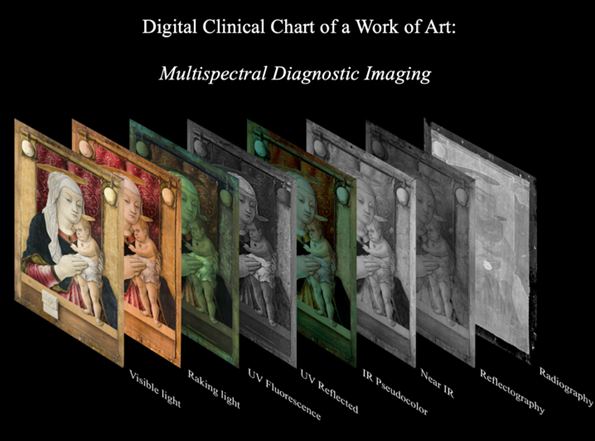
Image courtesy to Maurizio Seracini
AD: What is the future of art?
MS: If science can become instrumental in rediscovering the true values of our cultural heritage, and using widespread modern technologies attract the interest and curiosity of new generations, then I can see a new renaissance for the role of art in the future. Hopefully, in the decades to come people will still feel linked to their past if it will be identified as fundamental for the creation of their identity.
If contemporary art will continue to be the expression of highly provocative and often shocking messages presented in a language often intelligible only for the artist, and with the deliberate intention to cut out any cultural continuity with centuries of art, soon people might not be able to see or understand any artistic value in a work of art. An art piece could soon become an item as any other to be sold or bought just for its cost and possible revenues, regardless its true value.
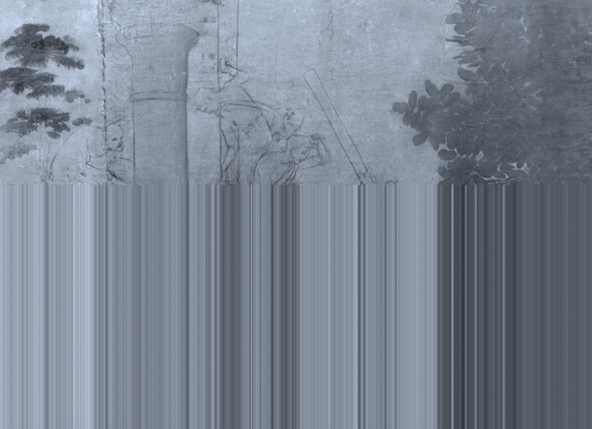
Infrared reflectogram, image courtesy to Maurizio Seracini
AD: What about the art market?
MS: Art will become more and more just an investment. At the same time if the art market will not force on itself strict rules of due diligence and if authentication will fail to become the way to make the art market somewhat transparent, art crimes will flourish more and more and, sooner rather than later, the art market bubble will burst.
AD: What is your dream project?
MS: To create a Foundation that could do research and development in the field of applied sciences to Cultural Heritage, could train a new breed of scientists to go out in the world to protect and conserve Cultural Heritage as well as giving their professional contribution to turn a purchase of a work of art from a risky investment into a sound asset class.
Finally, the role of the Foundation should be to study masterpieces in order to unveil their secrets to the world, and in the process to create a invaluable data base that thanks to AI, could bring authentication to an absolute level of certainty and could ultimately be the most objective and comprehensive way to attribute a work of art, bringing about a true revolution in the art world!!
AD: What role does the artist have in society?
MS: First an artist should study to become an artist, learning his trade as generations of artists have done in the past, otherwise it would appear to me like cheating. As for the role of an artist today, I feel he bears responsibility toward society.
Since his artistic creations are meant to be seen, they should convey emotions, feelings or even reactions to people. In the digital world we live in today, an art work can become a very powerful way to reach out to people, provided it bears values, meanings, messages that resonates with them. Imagine if Leonardo could have had such media exposure possibility, what impact his art could have had in people worldwide!
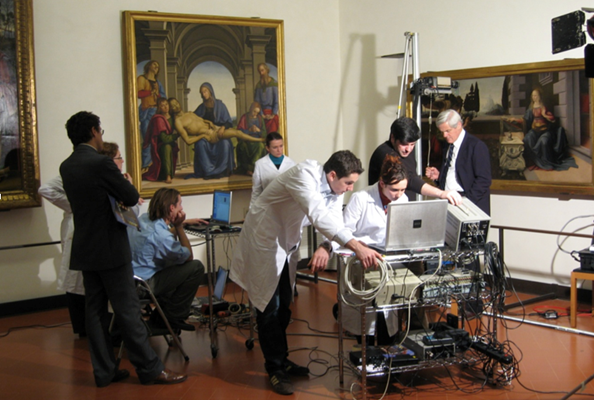
Diagnostic studies on Leonardo's Annunciation and Adoration of the Magi, Florence
AD: What memorable responses have you had to your projects?
MS: When I have the pleasure and privilege to lecture young kids and I can see sparks in their eyes when I show them the secrets of great masterpieces that I studied, which were unveiled thanks to science, I feel that 42 years spent trying to use science to give a future to our past, have been worth the frustration, the solitude, the antagonism and the many failures I had to go through.
AD: What do you dislike about the art world?
MS: In the art market, I dislike the lack of rules which allow criminal behaviour to flourish (money laundering is just one of the many art crimes).
In the art world (including museums), the resilience put up by art historians and restorers alike, to prevent scientists to turn conservation into a real science and allow them to manage conservation issues that are far too complex for them..
AD: What role does art funding have?
MS: I would like to see funding used to do conservation rather than just restoration
AD: What research do you do?
MS: Working in the development of portable instruments in order to examine better and faster works of art where they are located rather than moving them to a lab (often not feasible, anyway).
AD: What will you be speaking at for our 2nd Annual UNFOLD Art Xchange ?
MS: Applied Sciences and Artificial Intelligence for the Authentication of Works of Art.

ArtDependence Magazine is an international magazine covering all spheres of contemporary art, as well as modern and classical art.
ArtDependence features the latest art news, highlighting interviews with today’s most influential artists, galleries, curators, collectors, fair directors and individuals at the axis of the arts.
The magazine also covers series of articles and reviews on critical art events, new publications and other foremost happenings in the art world.
If you would like to submit events or editorial content to ArtDependence Magazine, please feel free to reach the magazine via the contact page.